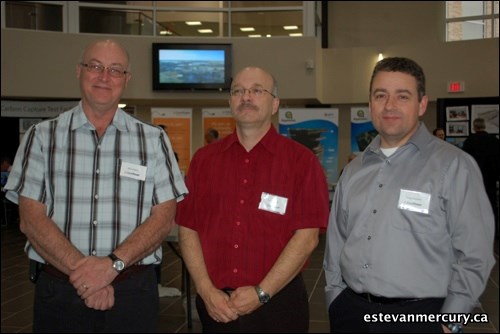It was time for another show-and-tell experience on Oct. 17 for SaskPower and its internationally observed clean coal project at Boundary Dam.
The $1.24 billion project that is around the halfway mark of the construction phase has caught the attention of global leaders in environmental protection and power production. It has also captured the attention and interest of local citizens who have generally supported it since its inception, so with that in mind, SaskPower staged an open house informational afternoon in the main auditorium at the Saskatchewan Energy Training Institute last Wednesday afternoon.
"Our last official open house was in 2010," said Doug Daverne, project manager. He had also led recent presentations to the Estevan and District Chamber of Commerce executive as well as city council.
"It's on time and on budget," the manager said, meaning that the September 2013 restart of Boundary Dam's Unit No. 3, which is undergoing a complete refurbishment, is still the target for that part of the process. Integrating Unit 3 with the carbon dioxide (and other gases) capture stripper vessel will be scheduled after the restart has been completed and checked out. By March of 2014, the capture plant should be ready for original testing, said Daverne.
"So far there are no big concerns. We have decided to use a waste water disposal well system for this project which is the preferred environmental move," he added.
The success or failure of the BD3 project will have huge implications for SaskPower and more likely the entire thermal powered electrical energy production industry around the globe.
"If it's not successful, then coal will have to be retired as a fuel source," said Daverne, pointing out that under new environmental regulations, old-style coal power plants won't qualify.
SNC Lavalin, the lead construction contractor on site, has now been joined by several other major contractors such as Graham Construction and PCL as the clean coal component moves past the halfway mark.
"There will be a lot more contractors on the scene next spring," said Daverne. "We peaked at about 800 on-site workers this year on all fronts, we're close to 800 again and it will be around 900 to 950 next year, so naturally we're concerned about accommodations. A lot will depend on what's happening in the oilpatch then and when the road bans will be on and off. We're looking at it carefully because there is the demand for skilled tradespeople. They won't come if they can't find a place. There was a temporary shortage of pipefitters earlier this year, probably because of the Co-op Refinery expansion in Regina, but there seems to be enough now and they're working an extra shift."
Daverne said that a lot of work is going on behind the scenes to promote the project on the international scale.
"We're not giving the intellectual properties away. Mike Monea (vice-president of strategic initiatives) is out selling the memberships right now," Daverne said with a smile. "There is a lot of international interest to this point and how it goes moving forward will be most interesting. So financial contributions are required and any company or country that is showing interest is getting the pitch."
Daverne added that as the value of the project and the fact it is a commercial-scale program becomes better known, Monea and others have been able to "push their way through that and they're getting the world to know. Mike is getting the message out and those who get involved will be able to monitor for a couple of years along with SaskPower who will then plan the next project and next decision while weighing all options."
The project manager said that BD3 will be cost competitive with other modes of electrical power production and the carbon dioxide capture capabilities, expected to be around 90 per cent, will far exceed national and international expectations and any existing or planned regulations.
"Then as the technology improves, the costs will be lowered. And as far as international interest is concerned, well, I would suggest that this project and the accompanying projects have already brought a lot of attention to this region and Estevan should be preparing for some more industrial tourism in the near future," Daverne said.
The open house at SETI included not only introductory information but also offered visitors more detailed exposure to such things as overall power supply planning for the province in the next five years, information regarding Boundary Dam and Shand Power Plants, environmental mitigation processes and the Aquistore project where the carbon dioxide that is captured from BD3 will be stored with the hope of using it later on as an agent for enhanced oil recovery in the nearby southeast Saskatchewan oilpatch.




